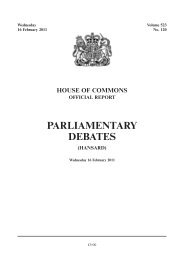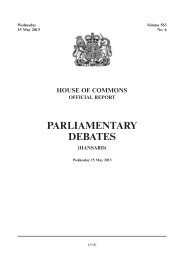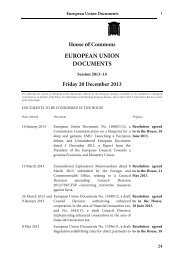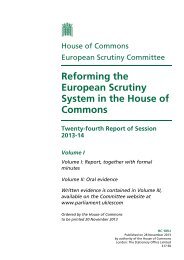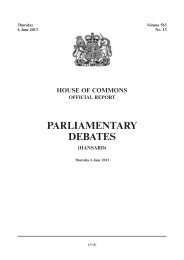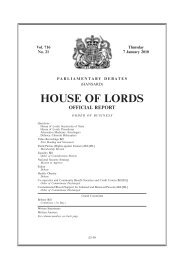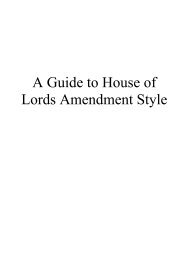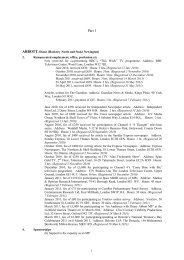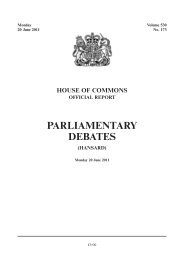Ticketing and Concessionary Travel on Public Transport - United ...
Ticketing and Concessionary Travel on Public Transport - United ...
Ticketing and Concessionary Travel on Public Transport - United ...
You also want an ePaper? Increase the reach of your titles
YUMPU automatically turns print PDFs into web optimized ePapers that Google loves.
about how the data <strong>on</strong> the smartcard itself is going<br />
to be c<strong>on</strong>figured, which is very important in <str<strong>on</strong>g>and</str<strong>on</strong>g> of<br />
itself. There is an ambiti<strong>on</strong> to see the ITSO<br />
smartcard be interoperable, but the questi<strong>on</strong> we<br />
have in our minds is, if you take the example of a<br />
customer who has got an ITSO smartcard, maybe<br />
from a library in <strong>on</strong>e of the cities somewhere in the<br />
UK, <str<strong>on</strong>g>and</str<strong>on</strong>g> who then goes <str<strong>on</strong>g>and</str<strong>on</strong>g> buys a ticket from a<br />
ticket retailer <str<strong>on</strong>g>and</str<strong>on</strong>g> takes the nati<strong>on</strong>al rail train down<br />
to L<strong>on</strong>d<strong>on</strong> <str<strong>on</strong>g>and</str<strong>on</strong>g> then arrives at our gate <str<strong>on</strong>g>and</str<strong>on</strong>g> the ticket<br />
does not work, what is that customer supposed to<br />
do? With Oyster it is very clear. We deal with the<br />
customer queries. Irrespective of where the customer<br />
came from, the query goes back to <strong>Transport</strong> for<br />
L<strong>on</strong>d<strong>on</strong>. In that model is it the issuer of the card or<br />
the seller of the ticket, who could be any<strong>on</strong>e, or the<br />
pers<strong>on</strong> who brought that pers<strong>on</strong> down to L<strong>on</strong>d<strong>on</strong>,<br />
which could be GNER or Virgin, or us? Who is<br />
going to deal with that? These are questi<strong>on</strong>s which<br />
are actually quite important when you start thinking<br />
about the way we deal with smartcards because<br />
people are not able to see what ticket they have.<br />
Q257 Mrs Ellman: What stage are you at in trying to<br />
deal with that? Are there any discussi<strong>on</strong>s going <strong>on</strong>?<br />
Mr Verma: There is a number of discussi<strong>on</strong>s going<br />
<strong>on</strong> right now about making the <strong>Transport</strong> for<br />
L<strong>on</strong>d<strong>on</strong> network capable of accepting ITSO<br />
smartcards in a technical sense, but the Department<br />
for <strong>Transport</strong> <str<strong>on</strong>g>and</str<strong>on</strong>g> the ITSO organisati<strong>on</strong> have left<br />
commercial arrangements between operators to the<br />
operators themselves. We have not been approached<br />
by any operator who wants to run an ITSO<br />
smartcard-based scheme in L<strong>on</strong>d<strong>on</strong> yet.<br />
Q258 Chairman: Forgive me, but that is a slightly<br />
disingenuous reply, Mr Verma. Nobody is actually<br />
going to come to you <str<strong>on</strong>g>and</str<strong>on</strong>g> say, “We are running <strong>on</strong>e<br />
system <str<strong>on</strong>g>and</str<strong>on</strong>g> we are making a reas<strong>on</strong>able profit <strong>on</strong> it<br />
<str<strong>on</strong>g>and</str<strong>on</strong>g> we would like actually to move to another <strong>on</strong>e,”<br />
unless you say to them, “The basic advantage will be<br />
X, Y, Z,” <str<strong>on</strong>g>and</str<strong>on</strong>g> presumably that is not what you<br />
have d<strong>on</strong>e?<br />
Mr Verma: What we have been able to tell people is<br />
the advantage of using a smartcard that we have<br />
realised.<br />
Q259 Chairman: That does not surprise me<br />
altogether. I think that is probably quite an eYcient<br />
thing to do, “Look, I do mine better than him.<br />
Mr Verma: Well, it is not a questi<strong>on</strong> of me doing<br />
mine better than him. There is a very specific<br />
rati<strong>on</strong>ale for introducing Oyster in L<strong>on</strong>d<strong>on</strong>, leaving<br />
aside the technology. The challenge we faced ten<br />
years ago was a three point challenge. The number<br />
of tickets being sold in the system was very, very<br />
large. We have, through the introducti<strong>on</strong> of Oyster<br />
<str<strong>on</strong>g>and</str<strong>on</strong>g> through the introducti<strong>on</strong> of Oyster pay as you<br />
go particularly we have cut down the number of<br />
tickets being sold in our system by 60%. Where we<br />
used to sell 1.8 milli<strong>on</strong> tickets per day we are selling<br />
800,000 tickets per day right now. So a milli<strong>on</strong> times<br />
a day some<strong>on</strong>e is not walking up to a ticket machine<br />
to buy a ticket, which is a huge advantage both to us<br />
as an operator <str<strong>on</strong>g>and</str<strong>on</strong>g> to customers. As an operator,<br />
5 December 2007 Mr Shashi Verma <str<strong>on</strong>g>and</str<strong>on</strong>g> Mr Steve Burt<strong>on</strong><br />
<strong>Transport</strong> Committee: Evidence Ev 31<br />
that is a step we would rather not cater to. We do not<br />
want to build ticket machines if people do not need<br />
to buy the tickets. The sec<strong>on</strong>d very important factor<br />
in the introducti<strong>on</strong> of Oyster was gate throughput,<br />
throughput through the gate, throughput through<br />
the bus network, <str<strong>on</strong>g>and</str<strong>on</strong>g> this is where very fast read<br />
speeds becomes very important. There are 25<br />
stati<strong>on</strong>s <strong>on</strong> the Underground network where in the<br />
morning, every weekday morning between 8.00 <str<strong>on</strong>g>and</str<strong>on</strong>g><br />
9.00 we put more than 25 people per minute through<br />
the gate line, so just over two sec<strong>on</strong>ds through the<br />
gate line. This is not just the time it takes to read the<br />
Oyster card, this is the time it takes for a customer to<br />
present themselves at the gate, tap the Oyster card,<br />
walk through the gate <str<strong>on</strong>g>and</str<strong>on</strong>g> clear the gate for the next<br />
customer to go through. If that transacti<strong>on</strong> time<br />
starts to decline, so if you start to put fewer than 25<br />
people through the gate line, that will mean that we<br />
need to increase the size of our gate lines, put more<br />
gates through, <str<strong>on</strong>g>and</str<strong>on</strong>g> with the kind of Victorian<br />
network we have got in many instances that is a very<br />
expensive propositi<strong>on</strong>, often costing tens of milli<strong>on</strong>s<br />
of pounds, because there is not the space to put more<br />
gates even if we wanted to. Those are both very<br />
important things. The third factor was that the very<br />
limited logic that was available <strong>on</strong> paper tickets<br />
meant there was a number of ways in which people<br />
were able to travel through the system at a fare which<br />
was lower than the fare they should have paid. An<br />
example of this would be if you bought a z<strong>on</strong>e 6 <strong>on</strong>ly<br />
paper ticket from Heathrow a few years ago you<br />
could travel all the way to Upminster in East<br />
L<strong>on</strong>d<strong>on</strong>, which is also a z<strong>on</strong>e 6 stati<strong>on</strong>. The fare<br />
should have been a z<strong>on</strong>e 1 to z<strong>on</strong>e 6 fare. You would<br />
have paid <strong>on</strong>ly a z<strong>on</strong>e 6 fare. You cannot do that any<br />
more with Oyster <str<strong>on</strong>g>and</str<strong>on</strong>g> as a result of the improvement<br />
<str<strong>on</strong>g>and</str<strong>on</strong>g> logic of that kind the lost revenue through—I<br />
would not necessarily call it fraud because it is not<br />
intenti<strong>on</strong>al as fraud, but the lost revenue from the<br />
system has declined quite markedly, so we are saving<br />
a large amount of m<strong>on</strong>ey <strong>on</strong> that count as well.<br />
Those are the benefits we have realised. Many of<br />
those benefits may be replicable in other parts of the<br />
country as well. Some may not, but some others<br />
may be.<br />
Chairman: I think you have started some hares<br />
running there!<br />
Q260 Clive EVord: I have always been obviously<br />
labouring under the misunderst<str<strong>on</strong>g>and</str<strong>on</strong>g>ing that the<br />
problem with our Victorian L<strong>on</strong>d<strong>on</strong> Underground<br />
was that there were too many people down there,<br />
getting down there too fast, not that we could not get<br />
them down there quick enough. I am frequently<br />
coming through Victoria Stati<strong>on</strong>, where I am forced<br />
to st<str<strong>on</strong>g>and</str<strong>on</strong>g> <strong>on</strong> the c<strong>on</strong>course because you cannot get<br />
any more people down <strong>on</strong> the trackside.<br />
Mr Verma: Victoria has a very special <str<strong>on</strong>g>and</str<strong>on</strong>g> very<br />
specific problem in that the stati<strong>on</strong> was built with<br />
<strong>on</strong>e entrance when it should have been built with<br />
two. That is something we are correcting at very<br />
large expense over the next few years. As a result of<br />
that there is a lot of crowding <strong>on</strong> the southern end.



